What would restaurant food look like if chefs actually cared about your long-term health? The restaurant standard of today, in which chefs don’t think twice about melting a stick of butter over your steak, worked in a time when dining out was reserved for special occasions. But in today’s world, where many eat out daily, it’s a desperately outdated model that is contributing to our collective obesity and chronic illness.
The real luxury food of today is a home-cooked meal – fresh, simple cooking made with a focus on both taste and health. But there aren’t too many people you can count on for that: maybe your mom, maybe your grandma, maybe just yourself. I can’t find food like that in restaurants. But I’ve found it in an unlikely place: Silicon Valley’s corporate cafeterias.
No mystery meat or mushy peas, the best Silicon Valley cafeterias offer local produce, sustainable seafood, grass-fed beef and hormone-free dairy, all prepared by professionally trained chefs. It’s restaurant-quality food but vastly better – because the chefs are given a mission to look after the long-term health of their diners, not simply to produce over-the-top single meals.
The results are remarkable – home cooked food for the masses. But more varied and creative than any single home cook could produce.
Back to the future
It’s funny that the back-to-basics approach of having real food cooked by chefs who care should be revived in the center of technology innovation. Technology is the answer to many of our problems, but today’s technology is not the future of prepared food.
On the low end, technology is food processing, where industrial corn and soy are broken down into components – hydrogenated oils, syrups, emulsifiers, starches, preservatives – and reassembled with salt and artificial flavorings into chips, cookies, cereals and other convenience foods. On the high end we have technology-enamored modernist cuisine featuring sous vide, where food is sealed in plastic and precision cooked in hot water.
The technology is fascinating, but to me cooking should be a sensory experience, from ingredient selection to the final plate. I don’t want my kitchen to be a laboratory. And I don’t want my food in foam form.
When I finish a restaurant meal, I groan and think about how to atone for it tomorrow. But when I visit my friends for lunch at Google, or Apple, I savor the variety of healthful options: enticing soups, colorful prepared salads, fresh seafood, Indian, Asian, vegan, gluten-free – and wish I could move in.
Here’s a sampling (many thanks to my secret sources for the photos!):
Mojito-marinated chicken thighs with fried plantains and corn succotash.
Steelhead trout with rice pilaf, sauteed kale, baby spinach and rainbow chard. Turns out steelhead trout, a variety of rainbow trout, is virtually identical to and more sustainable than salmon. When was the last time you learned something about food at your workplace cafeteria?
Vegetarian black bean tacos with a southwest slaw.
Ham and apple Brie melt with baby spinach, whole grain mustard and walnut vinaigrette. And a mizuna salad.
Garganelli with meat sauce. The meat is bison, not beef – Steve Jobs banned beef from the Apple cafeterias, to the outrage of burger-loving employees. But now they have bison – like beef, but better.
Here’s a pickled vegetable bar – very California. And people are all over it!
Here’s a bar with universal appeal – real gelato, just like Italia.
Food = Investment in people
If I didn’t have four kids at home, I might have to revive my corporate finance career just so I could get healthy food every day that I didn’t have to make myself. And they’d even pay me! No wonder cafeterias have become a legitimate recruiting tool among the hot firms of Silicon Valley.
In many cases the food is free; in others it is heavily subsidized. But this isn’t charitable giving. Companies have a vested interest in keeping employees on site (better productivity), interacting with one other (opportunities for collaboration), happy (lower employee turnover) and healthy (lower absenteeism and health care costs). Providing quality food is investing in people.
Brain food revolution
From the beginning, Google’s founders Larry Page and Sergey Brin wanted to serve their employees good food that would keep them engaged and inspired. In 1999, they tried out 25 chefs before offering the job to Charlie Ayers, former private chef to the Grateful Dead, who was paid based on the number of employees that stayed at work to eat. Ayers’s ongoing success, which kept pace with Google’s breathtaking rise, sparked a cafeteria revolution.
Apple poached some Google chefs to jumpstart its own impressive operation, but not every technology company wants to be in the in-house restaurant business. Smart players in the food service industry have jumped onto the brain-food bandwagon too. Palo Alto-based Bon Appetit Management Company, which operates cafeterias for Cisco, Oracle and Yahoo, as well as many other companies and universities, has increasingly put its purchasing power behind sources that are local, sustainable, humane toward animals and farm-labor responsible. The impact goes beyond the consumers.
The smart cafeterias use food service psychology to promote health as well. Google makes an active effort to help its employees make good dining choices. Healthier options are up front, bad stuff is de-emphasized. Labels have a simple green, yellow, red rating system. They offer smaller plates. And dessert portions are sized for three bites. It’s not paternalistic (unlike Steve Jobs’s beef ban) – it’s a way to help people help themselves. Kind of the opposite of supermarkets putting candy and snack foods at the register, or fast-food restaurants selling supersize everything for additional pennies. Simple stuff, but an effective way of showing diners a better way.
And chefs seem eager to get on board. Oracle’s executive chef came from San Francisco’s famed Jardiniere restaurant. Better pay and weekends off also help.
Clear-conscience dining
A meal should be a nourishing, enjoyable experience. We shouldn’t have to fear what’s in the food we eat. Or feel bad about ourselves afterward.
Quality food doesn’t have to be expensive, as Chipotle and Panera have demonstrated in the US, or Pret a Manger in the UK. It’s more a matter of vision and choices.
Andrew Knowlton of Bon Appetit magazine wrote an essay recently entitled “Dear Chefs, Are You Trying to Kill Me?”, about the excess of bacon, cream and other richness in restaurant food. To me that kind of cooking is lazy and irresponsible. Anyone can serve up a tasty meal. But a tasty, healthful meal takes both thought and care.
I’m not just appealing to the conscience of food providers out there. It’s good business as well. A heavy or junky meal can only be eaten once in a while. But quality, nutritious food can be eaten three times a day. Why not keep them coming back for more?
Doing good doesn’t have to be a profit sacrifice. There’s an inspiring, humble TEDTalk by Ray Anderson of Interface, maker of Flor carpeting, on how taking his environmentally-taxing business green was as smart financially as it was socially. Anderson was initially driven by his conscience, and people thought he was foolish. But the corporate mission drove innovation, gave employees meaning in their work and attracted top talent to the company. And in the end the company performed better than it ever had before. “The Business Logic of Sustainability” at TED.com
Food businesses can do this too: Give people a product that they feel good about buying and consuming. Provide a market for quality suppliers. Give employees meaning to their work.
Silicon Valley cafeterias have paved the way. I can’t wait until the restaurant industry catches up.
Related links
- A profile of Fedele Bauccio, co-founder of Bon Appetit Management Company, and his quest to bring real food and real chefs to food service. It must be the Italian in him.
- Apple and Google don’t make their menus public, but Yahoo, whose cafeteria is run by Bon Appetit, does.
- How Google encourages people to make smart food choices Bon Appetit magazine
- Google’s braised chicken and kale recipe
- A look inside Google’s cafeteria (normally they don’t let you take pictures) by Amateur Gourmet
- A response to Andrew Knowlton’s piece by my friend, chef Jamie Levine, who has trained at some of NYC’s best restaurants: “No, I’m Not Trying to Kill You.”

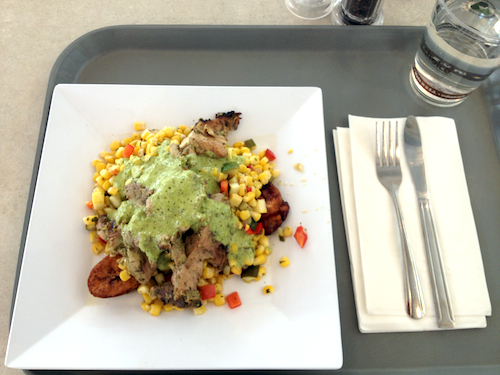
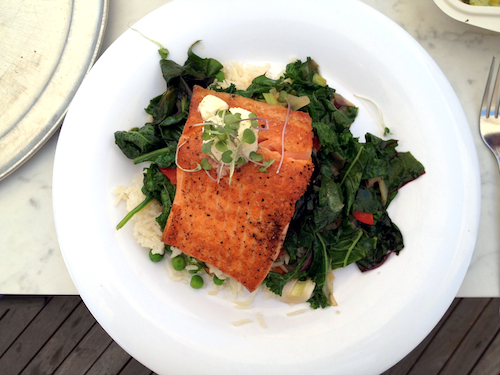
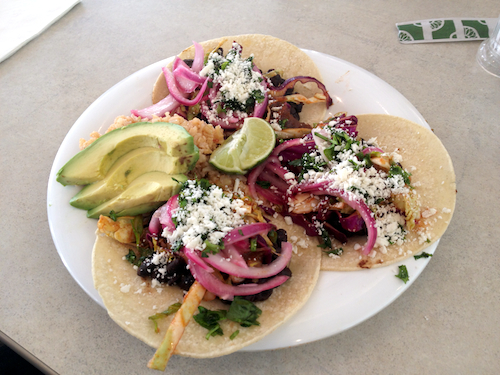
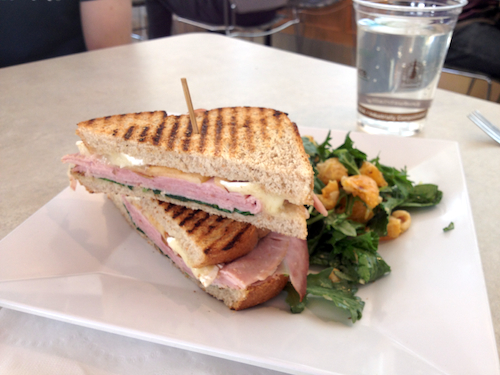
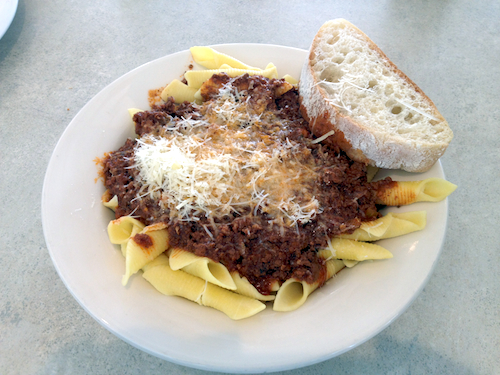
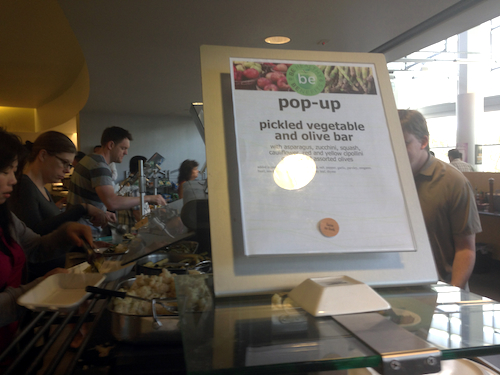
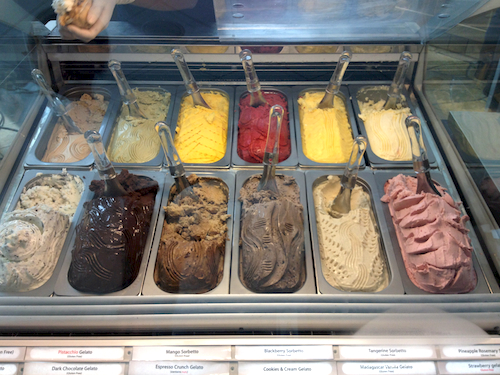




Love this sneak peek!
How exciting! Thanks for this glimpse into what We can only hope is the future of dining out. Eagerly awaiting the trickle-down, and I hope it comes quickly.
hi kathieb – me too. thanks for taking the time to comment!
I also like LYFE Kitchens in Palo Alto for healthy, casual and reasonably priced food.
thanks, grace – i’ll have to check it out!
I can’t wait until the UK government catches up, and invests in the health and education of kids by providing nutritious, tasty school lunches! It took Jamie Oliver to shame the previous government into putting children’s nutrition on the agenda, progress that has once more been eroded by the present lot! I’m not one to put all things French on a pedestal, but I do think they have got it right when it comes to feeding their children and workforce. They have always prioritised the provision of healthy, tasty, affordable meals in school and workplace canteens. And yes, it’s all about priorities – how do employees eat well if they are only allowed a half hour lunch break or if they are expected to remain at their desks all day? How do you ensure quality school meals if contracts are awarded to providers whose sole aim is to maximise profits? You can’t, and the recent horse meat in school meals scandal, not to mention childhood obesity, is testament to that. Thanks for a thought-provoking post, CG.
hi mm – yes, school lunches are another really important issue. my kids bring lunch from home every day, but i’d love to have better alternatives.
Lilian, I absolutely love this. Exactly what we were talking about. I think I mentioned to you that I had lunch at facebook and was blown away by the “helping one help themselves” attitude. I also love how you point out that from a business standpoint, offering food that can be consumed 3 times a day rather than once on your birthday is advantageous (and common sensical- not that all restaurants need to fit in one kind of mold). You should seriously submit this to the Huff Post….very interesting and well written.
hi jamie – this one was for you, starting with the foodist piece we discussed. so happy to have found a kindred spirit on food philosophy. =)
Aww :). Me too. Did you get to talk to Carrie of la pomme de Portland? Her and I also discussed similar thoughts. I hope we can all hang again some time!
LinkedIn also uses Bon Appetit:
http://linkedin.cafebonappetit.com
hi jag – thanks for sharing!